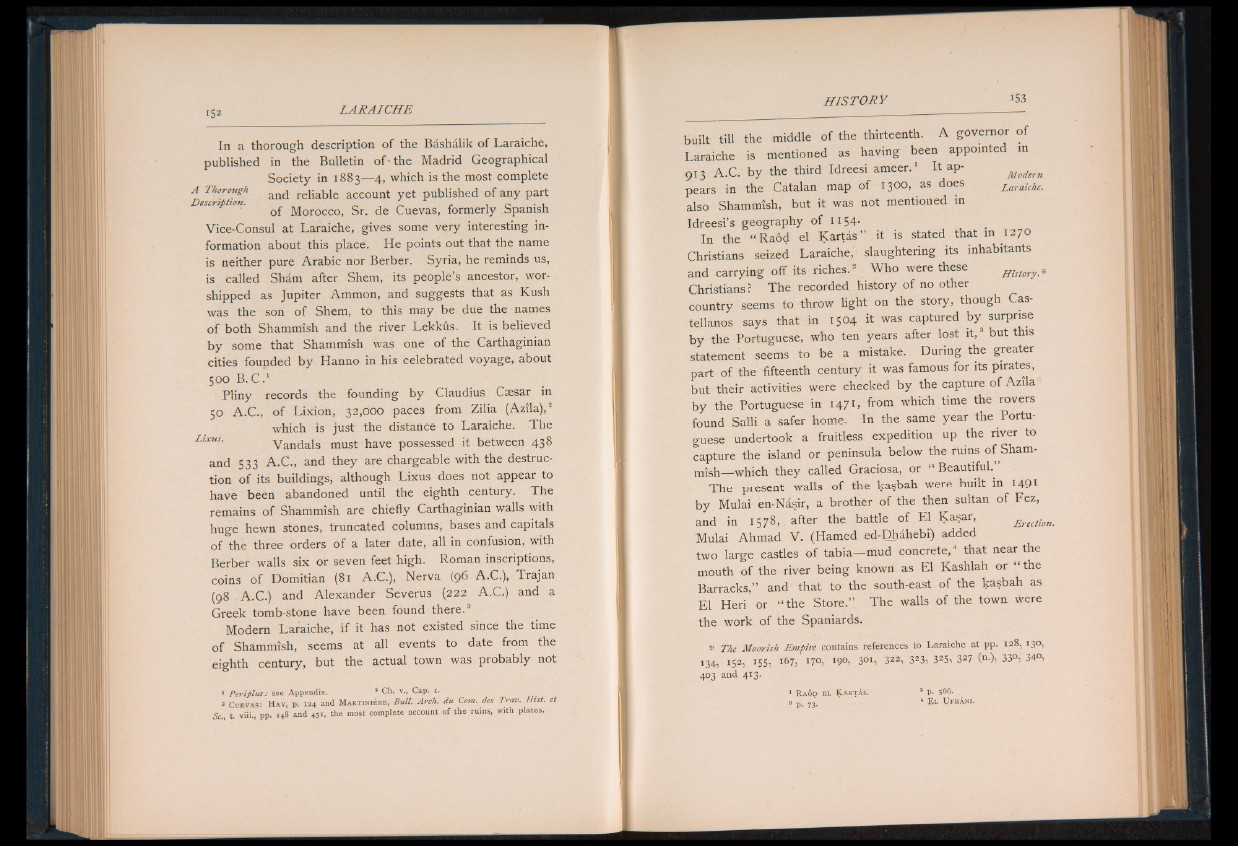
In a thorough description of the Bashalik of Laraiche,
published in the Bulletin of-the Madrid Geographical
Society in 1883— 4, which is the most complete
A Thorough an(j reliable account yet published of any part
of Morocco, Sr. de Cuevas, formerly Spanish
Vice-Consul at Laraiche, gives some very interesting information
about this place. He points out that the name
is neither pure Arabic nor Berber. Syria, he reminds us,
is called Sham after Shem, its people’s ancestor, worshipped
as Jupiter Ammon, and suggests that as Kush
was the son of Shem, to this may be due the names
of both Shammish and the river Lekkus. It is believed
by some that Shammish was one of the Carthaginian
cities founded by Hanno in his celebrated voyage, about
500 B .C . 1
Pliny records the founding by Claudius Caesar in
50 A.C., of Lixion, 32,000 paces from Zilia (Azila),2
which is just' the distance to Laraiche. The
Mxus. Vandals must have possessed it between 438
and 533 A.C., and they are chargeable with the destruction
of its buildings, although Lixus does not appear to
have been abandoned until the eighth century. The
remains of Shammish are chiefly Carthaginian walls with
huge hewn stones, truncated columns, bases and capitals
of the three orders of a later date, all in confusion, with
Berber walls six or seven feet high. Roman inscriptions,
coins o f Domitian (81 A.C.), Nerva (96 A.C.), Trajan
(98 A.C.) and Alexander Severus (222 A.C.) and a
Greek tomb-stone have been found there.3
Modern Laraiche, if it has not existed since the time
of Shammish, seems at all events to date from the
eighth century, but the actual town was probably not
1 P e rip lu s : see Appendix. 2 Ch. v., Cap. i.
3 C u e v a s : H a y , p. 12 4 and M a k t in i e r e , Bull. Arch, du Com. des Tram. Hist, et
Sc., t. viii., pp. 148 and 451, the most complete account o f the ruins, with plates.
built till the middle of the thirteenth. A governor of
Laraiche is mentioned as having been appointed in
913 A.C. by the third Idreesi ameer.1 It ap-
pears in the Catalan map of 1300, as does Laraiche.
also Shammish, but it was not mentioned in
Idreesi’s geography of 1154-
In the “ Raod el Kartas” it is stated that in 1270
Christians seized Laraiche,' slaughtering its inhabitants
and carrying off its riches.3 Who were these ffJstory*
Christians? The recorded history of no other
country seems to throw light on the story, though Castellanos
says that in 1504 it was captured by surprise
by the Portuguese, who ten years after lost it ,3 but this
statement seems to be a mistake. During the greater
part of the fifteenth century it was famous for its pirates,
but their activities were checked by the capture of Azila
by the Portuguese in 1471, from which time the rovers
found Salli a safer home. In the same year the Portuguese
undertook a fruitless expedition up the river to
capture the island or peninsula below the ruins of Sham-
mish— which they called Graciosa, or “ Beautiful.
The present walls of the kasbah were built in 1.491
by Mulai en-Nasir, a brother of the then sultan of Fez,
and in 1578, after the battle of Kasar, Erection.
Mulai Ahmad V. (Hamed ed-Dhahebi) added
two large castles of tabia— mud concrete,4 that near the
mouth of the river being known as El Kashlah or “ the
Barracks,” and that to the south-east of the kasbah as
El Heri or “ the Store.” The walls of the town were
the work of the Spaniards.
* The Moorish Empire contains references to Laraiche at pp. 128, 130,
134, 152, 155, 167, 170, 190, 301, 322, 323, 325, 327 (n.), 330, 340,
403 and 413.
1 R a &d e l K a r t a s . 2 ?■ S66-
3 p, y j, 4 E l T J f r a n i .